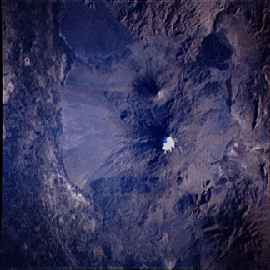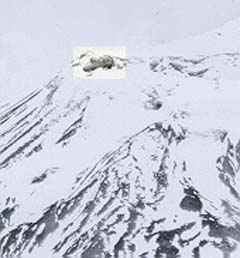pop up description layer
HOME
Cryptozoology UFO Mysteries Aviation Space & Time Dinosaurs Geology Archaeology Exploration 7 Wonders Surprising Science Troubled History Library Laboratory Attic Theater Store Index/Site Map Cyclorama
Search the Site: |
|
So God said to Noah, "I am going to put an end to all people, for the earth is filled with violence because of them. I am surely going to destroy both them and the earth. So make yourself an ark of gopher wood; make rooms in it and coat it with pitch inside and out. This is how you are to build it: The ark is to be 300 cubits long, 50 cubits wide and 30 cubits high. Make a roof for it and finish the ark to within one cubit of the top. Put a door in the side of the ark and make lower, middle and upper decks. I am going to bring floodwaters on the earth to destroy all life under the heavens, every creature that has breath of life in it..." Genesis 6:13-17 It was in 1959 that a pilot on a NATO-mapping mission first photographed something strange on a foothill 15 miles south of Mt. Ararat. When Captain Ilhan Durupinar of the Turkish Air Force examined the photographs using a stereoscopic technique the object looked like it was shaped like a ship. An examination by a photogrammetry expert, Dr. Arthur Brandenberger of Ohio State, seemed to confirm that the object was foreign to the area. But what was a ship doing in the high mountains of eastern Turkey? Given the location, some speculated that the structure might have been the remains of Noah's Ark from the biblical story. Pictures appeared in the September 5th, 1960 edition of LIFE Magazine with the caption "Noah's Ark?" They showed a boat-like structure with a pointed prowl and rear, roughly about the same site as the Ark described in the Bible. A group called Archaeological Research Foundation sent an expedition to the location to take a closer look. After examining the object, the group concluded that it was a geological freak caused by clay being upthrust through a lava field. The expedition found no artifacts or petrified wood. The observation by the Turkish pilot wasn't the first sighting of the ark since the days of Genesis. Reports about it have cropped up in various accounts by travelers and historians for thousands of years. Josephus, the first-century Jewish historian, mentions it several times in his works, but not as an eyewitness. He quotes Berosus, a Chaldaean, who wrote around 275 BC that "It is said, moreover, that a portion of the vessel still survives in Armenia on the mountain of the Cordyaens, and that persons carry off pieces of the bitumen, which they use as talismans." Epiphanius, the Bishop of Salamis, wrote in the 4th century that remains of the ark could still be seen in the "mountains of the Gordians," noting that if visitors look closely enough they can still find the altar Noah erected to worship God upon his return to dry land. A traveler of the 12th century, Benjamin of Tudela, said that Omar Ben al-Khatab removed the remains from the summit of Ararat and used the material to construct a mosque. Despite these accounts, the location of the final berth of Noah's ark has been in dispute. The Bible notes that the ark "came to rest upon the mountains of Ararat." While this has led many modern searchers to look at Mt. Ararat itself, the name was not actually associated with the mountain until the 11th century. In earlier times Ararat was an ancient name for Armenia, and the passage from the Bible seems to imply that it could have grounded on any of the mountains in that region. The Koran, which also carries a version of the story, indicates the final resting place was Mount Judi. The first modern explorer who claimed to have found the ark was James Bryce of Oxford University. Bryce climbed Mount Ararat in 1876. Near the peak he discovered a four-foot long stick and decided, for no apparently logical reason, it must be part of the ark. In 1892 Archdeacon John Joseph Nouri declared he had found the ark and had even entered it. After measuring it, he found it to be 300 cubits long, just as the Bible had said. Expeditions to find the ark continued through the early years of the 20th century. While a few claimed some success, most, like the Archaeological Research Foundation's trip, found nothing or purely natural phenomenon. Exploration on Mt. Ararat itself was often impossible due to political unrest and war.
In 1984 a man named Ron Wyatt convinced Jim Irwin (a former astronaut that had walked on the moon) and several others to go back to the site discovered in 1959. This new expedition discounted the findings of the 1960 expedition and declared that the formation was indeed Noah's ark. Wyatt made a number of visits to the site and also found some eleven large, flat stones with holes cut through them. Wyatt believed the stones, which weighed from 4 to 10 tons, to be anchor drogues that might have been attached to the ark via ropes running through the holes. The stones are over ten miles from the "ark" formation, leading Wyatt to conjecture that Noah may have cut them loose when he knew he was near a landfall. Wyatt also brought with him David Fasold, another explorer interested in finding the remains of the ark. Together they probed the formation with metal detectors and ground radar. The most promising things they found were material the looked like petrified wood, and fragments of something that looked like a bracket which the metal detector indicated was metallic, perhaps iron. The results of the ground radar test suggested the object had an internal structure that might be interpreted as rooms.. On close inspection the "wood" seemed to lack growth rings, but some biblical experts point out that the "gopher wood" referred to in the bible has no good translation and gopher wood might be bundles of reed coated with some sticky substance, like pitch, that would hold them together. Fasold believes the ark may have been an overly-large proto-Sumerian-type craft of bundled reeds. This might make sense since it is difficult to build a sea-worthy wooden ship over 300 feet in length. Initial tests on the "bracket" seemed to suggest it was iron, but Fasold became suspicious when the Turkish government, which had initially embraced the discovery, seemed reluctant to excavate the site. Fasold had the object re-tested. The second tests conducted by Gene Collins of the Department of Geological Sciences indicated that the "bracket" was a natural formation, with iron deposits. Tests on the samples of the "drogue anchors" suggest that they are rock local to the area, and not from Mesopotamia, where Noah was thought to have built the ark and would have quarried any anchors.. The actual "ship" formation itself Collins believes is a natural outcropping shaped to pointed ends by weathering, erosion and the effects of landslides moving around it. Fasold, who no longer believes the structure is the ark, hypothesizes that the outcropping maybe what the ancient travelers thought was the ark. Even Wyatt suggests that there are signs of an ancient platform that may have been constructed to allow tourists to view the "ark." If this is true, it makes the outcropping itself of some archaeological interest, but for different reasons. If Wyatt's object is not the ark itself, where is it? Some ark hunters think it is up at the top of Ararat, perhaps embedded in a glacier. Photographs taken in 1949 and just recently released by the U.S. government show a strange anomaly near the 15,500 foot level. There are several stories told by local people who claim they have seen the ark on Ararat and even walked on its deck. Entombed, it only makes an appearance occasionally in warm weather when the ice melts. As attractive as this scenario is, the mechanics of a glacier seem to make this unlikely. As it flows down the mountain over thousands of years, any object caught in it would be torn to shreds leaving only tiny pieces. If that is the case, the ark is probably scattered across the base of the mountain never to be recovered. Dr. Robert Ballard, who became famous as the discoverer of the wreck of the Titanic, has another theory about the ark. Through the end of the last ice age 12,000 years ago, sea levels sank more and more as water was frozen into the world's polar ice packs. The Black Sea, just east of Turkey, was cut off from the Mediterranean Sea by a set of mountains. As the world warmed and the ice packs melted about 7,500 years ago the ocean rose but the Black Sea, still protected from the the Mediterranean by a natural dam, stayed at its old level. The difference eventually reached 500 feet. Then something (perhaps a minor earthquake or a huge rainstorm) caused the dam to collapse. The result was a waterfall 200 times as powerful as Niagara that could be heard 300 miles away. The Black Sea expanded along some of its shallow shorelines at the rate of a mile a day, undoubtedly covering seaside villages in less than a week..
While this flood would have not covered the world, it certainly would have been cataclysmic to anyone in the local area. Ballard theorizes that this is the flood referred to in the Biblical story, as well as other similar flood stories from other cultures. By a quirk of nature anything caught in the flood should be well preserved. The salt water running in from the sea 7,500 ago would have been heavier than the fresh water already there. Without deep-water currents that exist in the oceans to stir the salt water, the depths of the Black Sea have been devoid of oxygen that is needed to support life. This means that there were no microbes to cause anything at the bottom of the sea to deteriorate. Ballard will try to use submarines to examine the bottom of the 7,500 foot deep sea in hope of finding perfectly-preserved ships, villages and other artifacts. He even speculates that the ark, or some other ark-like ships, might even be down there. One thing is certain, though, until somebody can find the remains of a 450-foot long vessel, either at the top of Ararat, or at the bottom of the Black Sea, or somewhere in between, there will always be adventurers looking for Noah's ark. Copyright Lee Krystek 2000. All Rights Reserved. |
|
Related Links |
|
|






